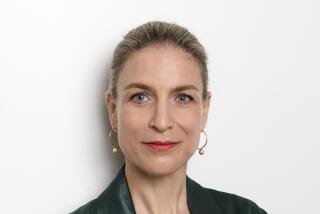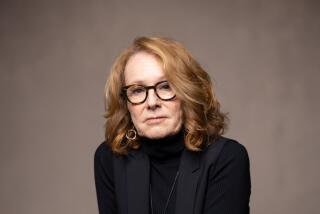Far from lonely at the top
- Share via
LAST September, the Solomon R. Guggenheim Museum announced that Lisa Dennison would be promoted from deputy director to director, and Dennison’s phone rang like crazy.
“In the first few days the calls were from women, women, women, to the point that I was surprised,” Dennison says. “Naturally, a lot of them were happy to see a woman at the helm of another museum. The men were slower. They eventually called or came around and sent flowers or a handwritten note. But the response was nothing like the women.”
For the record:
12:00 a.m. June 11, 2006 For The Record
Los Angeles Times Sunday June 11, 2006 Home Edition Main News Part A Page 2 National Desk 1 inches; 40 words Type of Material: Correction
Nat Sutton: An article in today’s Calendar about the growing number of women serving as museum directors says Nat Sutton is a managing partner of Korn/Ferry International, an executive search firm. Sutton is a managing partner of Heidrick & Struggles.
For The Record
Los Angeles Times Sunday June 18, 2006 Home Edition Sunday Calendar Part E Page 2 Calendar Desk 1 inches; 45 words Type of Material: Correction
Nat Sutton: An article last Sunday about the growing number of women serving as museum directors incorrectly said that Nat Sutton is a managing partner of Korn/Ferry International, an executive search firm. Sutton is a managing partner of the executive search firm Heidrick & Struggles.
Many of the women calling Dennison were themselves museum directors. Although women rarely ascend to the top of corporate America -- just 1.9% of Fortune 1000 companies have female chief executives, according to Fortune magazine -- female art museum directors have become commonplace.
The Assn. of Art Museum Directors membership is 38% female, says executive director Mimi Gaudieri, and six of this year’s applicants are women too.
Women are especially prominent at the nation’s top tier of modern and contemporary art museums. The UCLA Hammer Museum in Los Angeles, the Walker Art Center in Minneapolis, the Hirshhorn Museum and Sculpture Garden in Washington, D.C., the Modern Art Museum of Fort Worth, the Contemporary Arts Museum Houston, the New Museum of Contemporary Art in New York, Site Santa Fe, the Blaffer Gallery at the University of Houston, the Institute of Contemporary Art Boston, the Institute of Contemporary Art in Philadelphia, the Museum of Contemporary Art North Miami, and the Guggenheim -- to name a few -- are all run by women.
A number of major encyclopedic museums, such as the Baltimore Museum of Art, the Seattle Art Museum and the Philadelphia Museum of Art, also have female directors. Until recently, women ran three of America’s biggest museums: the Los Angeles County Museum of Art, the J. Paul Getty Museum and the Cleveland Museum of Art. And it was a woman who led museum directors into a recent pop culture crossover: Jennifer Beals’ character, Bette Porter, on Showtime’s comedy-drama series “The L Word,” was inspired by none other than the Hammer’s director, Ann Philbin.
This is all a significant shift from 1994, when Times art critic Christopher Knight noted that among museums “generally considered the largest or most significant,” only Seattle, Philadelphia and the Walker were run by women.
So what’s happened since?
“You mean, other than that women are just more talented than men?” Dennison asks, laughing.
Joking aside, directors point to women’s long history of involvement in museum-dom, the culmination of decades of institutional advancement and greater diversity on the boards of trustees that hire directors.
Since the late 19th and early 20th centuries, there has been a link between progressive institutions showing the most recent art and women. Perhaps because the great encyclopedic museums of the day, such as the Metropolitan Museum of Art in New York, were outgrowths of male-dominated business and political realms, women gravitated toward establishing new museums for new art.
In 1892, 20 Fort Worth women joined to form what has become the Modern Art Museum of Fort Worth. In New York, women founded the Whitney Museum of American Art in 1931 and the Museum of Modern Art in 1929. In 1934, Grace McCann Morley became the founding director of the San Francisco Museum of Art, which later became the San Francisco Museum of Modern Art.
“I think that with the modern museums, to get started was also relatively cheap,” says Alan Wallach, a professor at the College of William & Mary in Virginia who has studied American museum history. “If you look at the way the ruling elites operate, it’s part of a sort of attempt to cover their bases culturally. This new thing, Modernism, is coming along. Maybe we should collect it. Maybe we should take a look at it.... The people who founded these museums were often female collectors, and they would get men to run these operations, or they would band together and then get a man to join them.”
*
Going contemporary
SEVERAL directors say today’s trend has its roots in the 1960s and 1970s, when museums began to hire curators of contemporary art and women, for the first time, filled those jobs in large numbers.
“It was a natural trajectory, as you grow and develop in your job, that you would take more responsibility and then take a helm,” says Terrie Sultan, the Blaffer director. “Naturally we were in the next generation of people to be considered for directorships. Those of us who became directors are all more or less the same age.”
Former curators who became directors include Anne d’Harnoncourt, 63, of the Philadelphia Museum of Art, who was a curator of 20th century art; Sultan, who describes herself as “50-something”; and Dennison, 53, Olga Viso, 39, of the Hirshhorn, and Lisa Phillips, 52, of the New Museum. All except d’Harnoncourt were contemporary art curators before their promotions.
That shared experience helped women form networks at the curatorial level, a kinship that has tended to endure as they have become directors, they say.
ArtTable, an organization of female arts professionals in “leadership positions in the visual arts” in both the nonprofit and commercial spheres, is 25 years old this year and has helped women form networks not just in museums but across the entire art world.
And the Assn. of Art Museum Directors has long had an ad hoc women’s caucus that organizes its own programming and has held events during larger AAMD meetings.
“I often hear from our male colleagues that they’re jealous of what we were doing at that meeting or who we were talking to,” says Marla Price of the Fort Worth museum, an AAMD member. At one point, she says, Ned Rifkin, the former director of the Hirshhorn and now the undersecretary for art at the Smithsonian, “got so mad -- or curious -- that he came to the women’s meeting.”
Walker Director Kathy Halbreich has a similar recollection: “That [regular] meeting really drove the men crazy, which was probably part of the reason why we did it. I think they thought there was a secret handshake. That always amused me greatly because, of course, for years the field was their private domain.”
Although some of the more recent hires, such as Dennison and Viso, shrug off that today’s art museum boards are more likely to hire men, longer-serving directors, such as Halbreich, who has run the Walker since 1991, and Price, who was promoted from chief curator to the Fort Worth directorship in 1992, are less convinced.
Price pointed out that it couldn’t have hurt her chances that a woman, Anne Marion, was Fort Worth’s board chairwoman when Price was named director. And when the Walker wanted to interview Halbreich 15 years ago, she was so concerned that she would be interviewed as a “token woman” that she sought assurances to the contrary before agreeing to go through the process.
“People tend to select people who look like them,” Halbreich says. “I know that was certainly there when I came up through the headhunter ranks. I don’t think that’s a cynical statement. I don’t intend it that way. That’s the human condition.”
Price says that one of the prime benefits of the peer networks that have sprung up in recent years is that female directors can compare notes about their boards. “Some directors who had been interacting with powerful businessmen on their board had started getting this ‘little missy factor,’ where the men on their boards would say, ‘Li’l missy, it’s fine if you want to talk to the weird artists, but let me handle the money.’ Most of us had a story like that.”
Price says being hired by a female-led board allowed her to avoid that problem.
Few would suggest that women moving into directorships has changed how museums are run. But once in the job, there are differences in how men and women approach some duties. “Let’s say you’re a male director,” Halbreich says. “You can easily fly off to Europe with a male board member to look at that work of art together. It is still not that easy for a woman director to fly off anywhere with a male trustee. There really are still cultural differences.”
Perhaps the best measure of an increasingly level playing field between men and women is that the recent hiring of men as directors at Cleveland, the Getty and LACMA appears to have barely caused a blip. Several female curators and directors say it never occurred to them that they couldn’t be directors -- that they never felt like there was a glass ceiling above which they couldn’t rise. They feel that women are at the point where gender isn’t considered.
“We’ve never been told by a selection committee or board to bring back a woman or man,” says Nat Sutton, a managing partner of Korn/Ferry International, the executive search firm. “In these [hiring] committee meetings, we talk about the job and the management responsibilities and the characteristics and qualities we’re looking for and what some of the key qualities will be. Then we go in the marketplace and we talk to a variety of people.”
That said, not one of the three flagship art museums in the United States -- the Met, America’s greatest encyclopedic museum, the National Gallery of Art, the national art museum, or MoMA, the world’s greatest museum of 20th century art -- has ever had a woman at the helm.
Not to worry, says Sultan: “A lot of those old gray eminences are going to be retiring in a number of years.
“Then see what happens.”
More to Read
The biggest entertainment stories
Get our big stories about Hollywood, film, television, music, arts, culture and more right in your inbox as soon as they publish.
You may occasionally receive promotional content from the Los Angeles Times.










